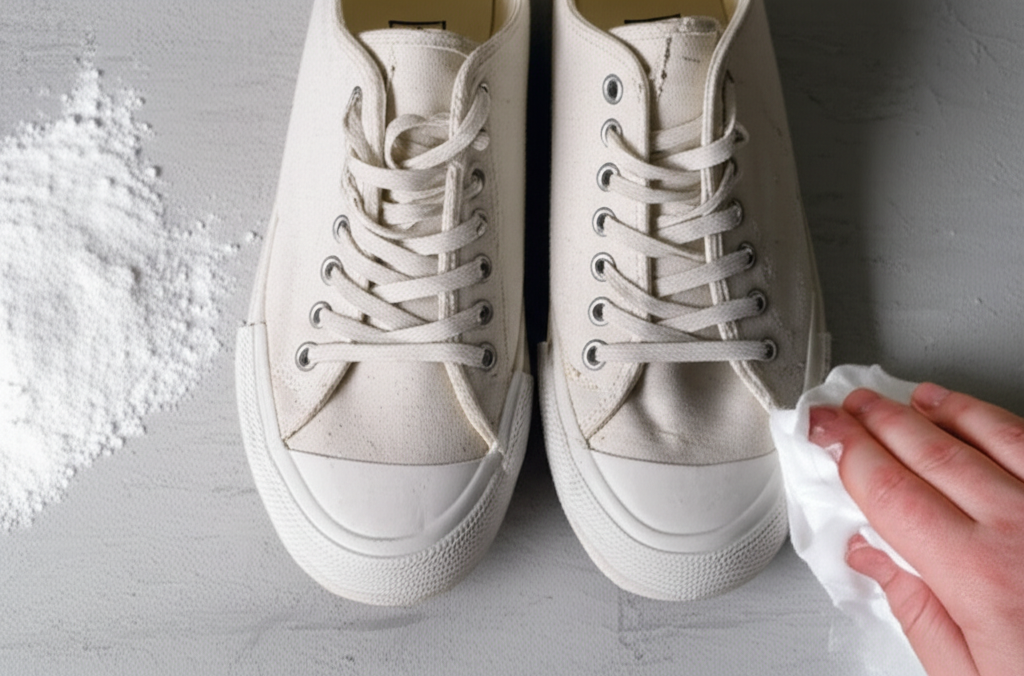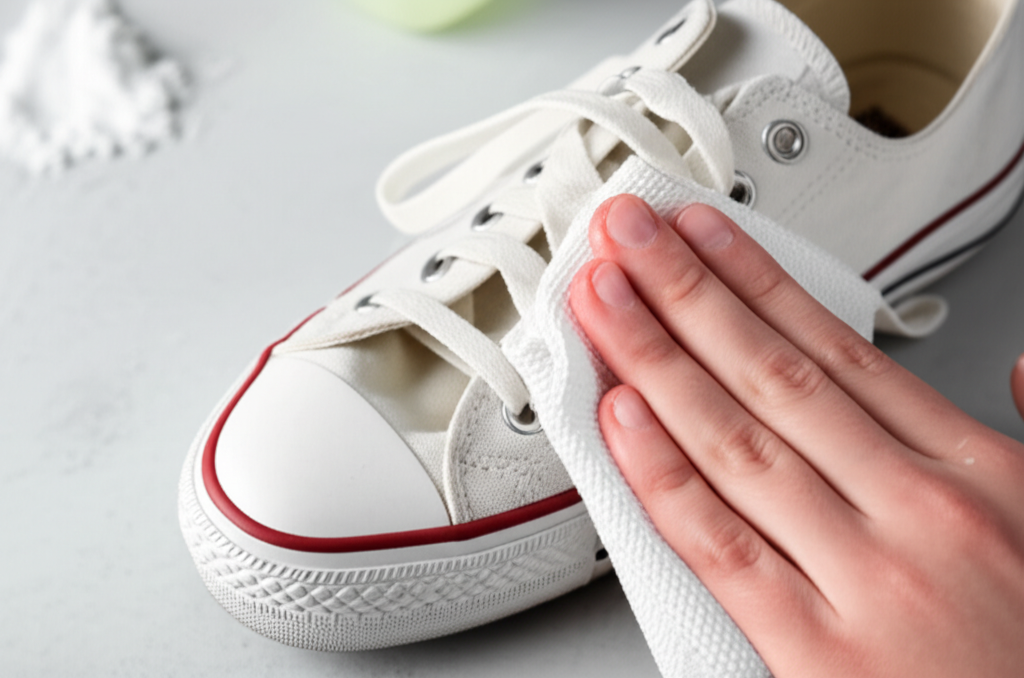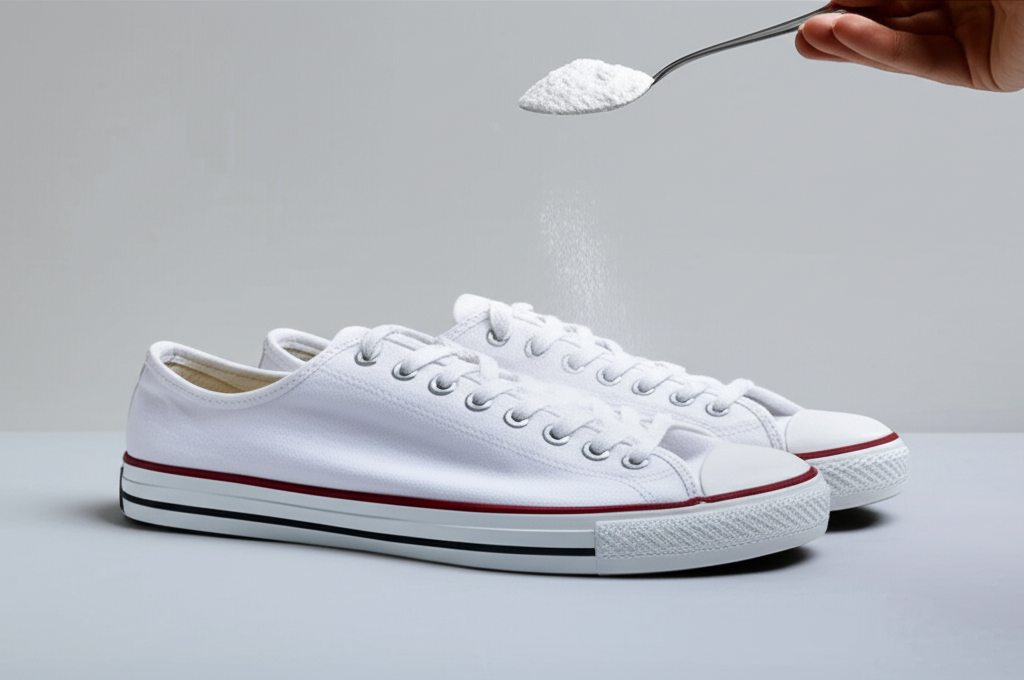Yes, baking soda can effectively clean and deodorize shoes, offering amazing results for common shoe issues like stains and odors. It’s a safe, affordable, and natural solution for various shoe materials when used correctly.
Key Takeaways
- Baking soda tackles shoe odors and stains effectively.
- It’s safe for most shoe materials, including canvas and leather.
- Use it as a paste for stains or as a deodorizer.
- Always test on an inconspicuous area first.
- Rinse thoroughly to prevent residue.
- Combine with other natural cleaners for tougher jobs.
Does Baking Soda Clean Shoes? Amazing Results!
We all love our favorite pair of shoes, whether they’re stylish sneakers, trusty boots, or comfy everyday wear. But life happens, and shoes can get dirty or start to smell. You might be wondering, “Does baking soda clean shoes?” The answer is a resounding yes! It’s a surprisingly powerful yet gentle cleaning agent that most of us already have in our kitchens. It can tackle stubborn stains and unpleasant odors, leaving your shoes looking and smelling fresher. If you’re looking for an affordable and natural way to keep your footwear in top shape, you’ve come to the right place. Let’s dive into how this humble pantry staple can work wonders for your shoes.
Understanding Baking Soda’s Cleaning Power

Baking soda, also known as sodium bicarbonate, is a mild alkali. This alkalinity is key to its cleaning prowess. It helps to break down grease, dirt, and grime. When mixed with water, it forms a paste that can lift stains. More importantly for shoes, baking soda is a natural deodorizer. Odors in shoes are often caused by bacteria that thrive in damp, dark environments. Baking soda works by neutralizing the acidic compounds that produce these smells, rather than just masking them. This makes it an excellent choice for tackling that lingering shoe odor that can be so embarrassing. Its gentle abrasive nature also means it can scrub away dirt without damaging most shoe materials, making it a versatile cleaner for your entire shoe collection.
Can Baking Soda Really Clean All Types of Shoes?
While baking soda is a versatile cleaner, it’s important to understand its suitability for different shoe materials. The effectiveness and safety can vary. For porous materials like canvas and fabric, baking soda is generally excellent. It can absorb moisture and odors effectively. For leather, it can help with stains and odor, but caution is needed to avoid drying out the material. Suede and nubuck, however, are more delicate. While dry baking soda can absorb grease stains from suede, wet applications should be avoided or done with extreme care. Always remember to test any cleaning solution on a small, hidden area of your shoe first to ensure it doesn’t cause discoloration or damage. This simple step can save you from ruining a beloved pair.
Baking Soda for Canvas and Fabric Shoes
Canvas sneakers and fabric shoes are probably the most common beneficiaries of baking soda cleaning. These materials are porous and prone to absorbing dirt and odors. Baking soda can be used in a few ways:
- For general cleaning and deodorizing: Sprinkle dry baking soda generously inside your shoes. Let it sit overnight, then shake or brush it out. This is a passive way to absorb moisture and odors.
- For stains: Mix baking soda with a small amount of water to create a paste. Apply this paste directly to the stained area. Let it dry, then gently brush it off. For tougher stains, you might need to repeat this process.
- For deep cleaning: You can add a quarter cup of baking soda to a bucket of warm water and soak your canvas shoes (if they are fully washable). After soaking, gently scrub them with a brush and rinse thoroughly.
Baking Soda for Leather Shoes
Leather shoes require a more delicate approach. Baking soda can help with minor scuffs and odor, but it’s crucial not to overdo it, as it can potentially dry out the leather. Here’s how to use it safely:
- For odor: Similar to fabric shoes, sprinkle dry baking soda inside the shoes and let it sit overnight. This will help absorb moisture and neutralize odors.
- For stains (use with caution): For light scuffs or marks, you can try a very dilute paste of baking soda and water. Apply sparingly with a soft cloth, gently rub the affected area, and then wipe clean immediately with a damp cloth. Follow up with a leather conditioner to prevent drying. Avoid this method on very delicate or patent leather.
It’s essential to condition your leather shoes after any cleaning, even with gentle methods, to maintain their suppleness and prevent cracking. Resources like American Leathers’ care guide offer valuable insights into maintaining leather goods.
Baking Soda for Suede and Nubuck Shoes
Suede and nubuck are notoriously tricky to clean. Baking soda can be a lifesaver for greasy stains, but it’s best used dry. Wetting suede can permanently damage its texture.
- For grease stains: Immediately after a grease stain occurs, sprinkle a generous amount of dry baking soda onto the spot. Let it sit for several hours, or even overnight, to absorb the grease. Then, gently brush it away with a suede brush.
- For general freshness: You can sprinkle dry baking soda inside suede shoes to absorb odors. Let it sit overnight, then shake or brush it out thoroughly.
Always use a dedicated suede brush to restore the nap of the material after cleaning. Avoid harsh scrubbing. For more extensive cleaning of suede, professional help might be the safest option.
How to Use Baking Soda for Shoe Cleaning: Step-by-Step

Ready to give your shoes a baking soda spa treatment? Here’s a simple, effective method for tackling common issues like dirt and odor. This guide focuses on a common scenario: cleaning canvas or synthetic sneakers.
Method 1: Deodorizing with Dry Baking Soda
This is the easiest and safest method for all shoe types.
- Ensure shoes are dry: This method works best on dry shoes.
- Sprinkle generously: Open up your shoes and sprinkle a good amount of baking soda inside, making sure to cover the insoles and corners.
- Let it work its magic: Leave the shoes in a well-ventilated area overnight, or for at least 8 hours. The baking soda will absorb moisture and neutralize odors.
- Remove excess: Shake out the shoes outdoors or over a trash can. Use a soft brush to remove any remaining baking soda residue.
Method 2: Cleaning Stains with a Baking Soda Paste
This is ideal for visible stains on canvas, fabric, or some synthetic materials.
- Gather your supplies: You’ll need baking soda, water, a small bowl, and a soft brush (an old toothbrush works well).
- Make the paste: In the bowl, mix baking soda with just enough water to form a thick paste. Aim for a consistency similar to toothpaste.
- Apply to stains: Dab the paste onto the stained areas of your shoes using your brush. Gently rub in a circular motion.
- Let it dry: Allow the paste to dry completely on the shoes. This can take a few hours.
- Brush off the residue: Once dry, use your soft brush to gently brush away the dried paste. You should see the stain lifting.
- Rinse (if necessary): For canvas or fabric shoes, you can lightly dampen a clean cloth with water and wipe away any remaining residue. Avoid oversaturating the shoes.
- Air dry: Let your shoes air dry completely away from direct heat or sunlight.
Method 3: Deep Cleaning with Baking Soda and Water Soak
This method is best for heavily soiled, washable canvas or synthetic shoes. Always check shoe care labels first!
- Prepare the solution: Fill a basin or sink with warm water. Add about half a cup of baking soda and stir to dissolve.
- Soak the shoes: Submerge your shoes in the baking soda water. Let them soak for at least an hour, or longer for very dirty shoes.
- Scrub: After soaking, use a soft brush to scrub away dirt and grime. Pay attention to the soles and any visible marks.
- Rinse thoroughly: Drain the dirty water and refill the basin with clean water. Rinse your shoes thoroughly, ensuring all baking soda residue is removed. You may need to rinse them under running water.
- Remove excess water: Gently squeeze out excess water, but do not wring. Stuff shoes with dry towels or newspaper to help them retain their shape and absorb moisture.
- Air dry: Allow shoes to air dry completely. This can take 24-48 hours.
Comparing Baking Soda to Other Shoe Cleaners
Baking soda is a fantastic option, but how does it stack up against other common shoe cleaning methods and products? Let’s look at a comparison:
| Cleaning Agent | Pros | Cons | Best For |
|---|---|---|---|
| Baking Soda | Affordable, natural, deodorizes effectively, mild abrasive, safe for many materials. | Can leave residue if not rinsed well, may not be strong enough for deep-set stains, requires caution on delicate materials like suede. | General cleaning, odor removal, light stains on canvas, fabric, synthetics. |
| Mild Dish Soap | Readily available, good at breaking down grease and grime, effective for general cleaning. | Can be too harsh for some delicate materials, might strip color, requires thorough rinsing. | Most fabric and synthetic shoes, light stains. |
| Specialty Sneaker Cleaners | Formulated for specific shoe materials, often effective on tough stains, come with specific instructions. | Can be expensive, may contain harsh chemicals, requires purchasing a specific product. | Tough stains, specific materials (leather, suede), preserving shoe appearance. |
| White Vinegar | Good disinfectant and deodorizer, effective against mold and mildew. | Strong smell (though it dissipates), can damage certain finishes if not diluted, can lighten colors. | Stubborn odors, disinfecting insoles. |
| Hydrogen Peroxide | Effective whitener for rubber soles and white canvas, disinfectant. | Can bleach colors, may weaken materials with prolonged use, requires careful application. | Whitening rubber soles, stubborn yellowing on white shoes. |
As you can see, baking soda offers a great balance of effectiveness, affordability, and safety for everyday shoe cleaning needs. For very specific or challenging issues, you might consider a specialized cleaner, but for most common problems, baking soda is a go-to solution.
Pro Tips for Maximum Shoe Freshness
To get the most out of baking soda and keep your shoes in excellent condition, consider these expert tips:
- Always test first: Before applying any baking soda mixture to your entire shoe, test it on a small, inconspicuous spot. This is especially crucial for colored or delicate materials.
- Don’t over-wet: For leather and suede, avoid getting them too wet. Use a damp cloth for rinsing, not a direct pour of water.
- Rinse thoroughly: Baking soda can leave a white, powdery residue if not rinsed properly. Ensure you wipe or rinse away all traces of the cleaner.
- Air dry only: Never put shoes in a dryer. High heat can warp materials, damage adhesives, and shrink shoes. Always air dry them away from direct heat sources.
- Combine with other natural cleaners: For tough stains or odors, you can sometimes combine baking soda with a small amount of mild dish soap or white vinegar (diluted). Always test this combination first!
- Regular maintenance is key: A quick sprinkle of dry baking soda inside your shoes every week or two can prevent odors from building up in the first place.
Common Shoe Cleaning Mistakes to Avoid
Even with a great cleaner like baking soda, it’s easy to make mistakes that can harm your shoes. Here are some common pitfalls to watch out for:
- Using hot water: Hot water can damage glues, shrink materials, and set stains. Always opt for cool or lukewarm water.
- Machine washing/drying without checking: While some canvas shoes can go in the washing machine, many cannot. Always check the care label. Never machine dry.
- Using harsh chemicals: Bleach and strong solvents can discolor and degrade shoe materials. Stick to gentle, natural cleaners when possible.
- Scrubbing too hard: Excessive scrubbing can damage the surface of your shoes, especially on delicate materials like suede or mesh. Use a soft brush and gentle motions.
- Ignoring care labels: Shoe manufacturers often provide specific cleaning instructions. Ignoring these can lead to damage. You can often find detailed care guides online for specific brands or types of footwear, such as those from the REI guide to cleaning hiking boots, which offers principles applicable to many outdoor footwear.
- Not drying properly: Improper drying can lead to mold, mildew, and odor development. Ensure shoes are fully dry before storing or wearing them.
Frequently Asked Questions About Baking Soda and Shoes
Q1: Can baking soda damage my shoes?
When used correctly, baking soda is generally safe for most shoe materials. However, it’s always recommended to test on an inconspicuous area first, especially for colored fabrics, leather, or suede. Avoid excessive scrubbing or leaving paste on for too long, as this could potentially affect the material’s texture or color.
Q2: How long should I leave baking soda in my shoes for odor?
For effective odor absorption, leave dry baking soda in your shoes for at least 8 hours, or preferably overnight. The longer it sits, the more moisture and odor it can absorb.
Q3: Will baking soda remove tough stains like ink or paint?
Baking soda is excellent for general dirt and grime, and can help lift lighter stains. However, for very stubborn stains like ink, paint, or deep-set grease, you may need stronger, specialized cleaners. Baking soda can be a good first step, but be prepared to try other methods if it doesn’t fully work.
Q4: Can I use baking soda on athletic shoes with mesh uppers?
Yes, baking soda is a great option for cleaning mesh athletic shoes. You can use the dry method for deodorizing or the paste method for light stains. Ensure you rinse the paste off thoroughly with cool water and allow the shoes to air dry completely.
Q5: What’s the difference between using baking soda and washing soda for shoes?
Baking soda (sodium bicarbonate) is a mild alkali. Washing soda (sodium carbonate) is a stronger alkali and is more caustic. While washing soda is a powerful cleaner, it’s much harsher and can easily damage shoe materials like leather, suede, and even some fabrics. It’s generally not recommended for shoe cleaning unless you are experienced and dealing with very durable, washable materials, and even then, with extreme caution and dilution.
Q6: How often can I use baking soda to clean my shoes?
You can use dry baking soda for deodorizing as often as needed, even weekly, especially if you wear your shoes frequently or live in a humid climate. For paste cleaning, it depends on how dirty your shoes get. Use it when you notice stains, but avoid over-cleaning, which can wear down materials over time.
Conclusion
So, does baking soda clean shoes? Absolutely! It’s a remarkably effective, wallet-friendly, and natural solution for tackling common shoe woes like odors and light stains. From refreshing your favorite canvas sneakers to helping with minor marks on leather (with caution), baking soda proves itself to be a versatile ally in your shoe care arsenal. By following the simple step-by-step guides and pro tips, you can confidently use baking soda to keep your footwear looking and smelling great, extending their lifespan and saving you money on expensive cleaning products. Remember to always test first and let your shoes air dry properly. Happy cleaning!

